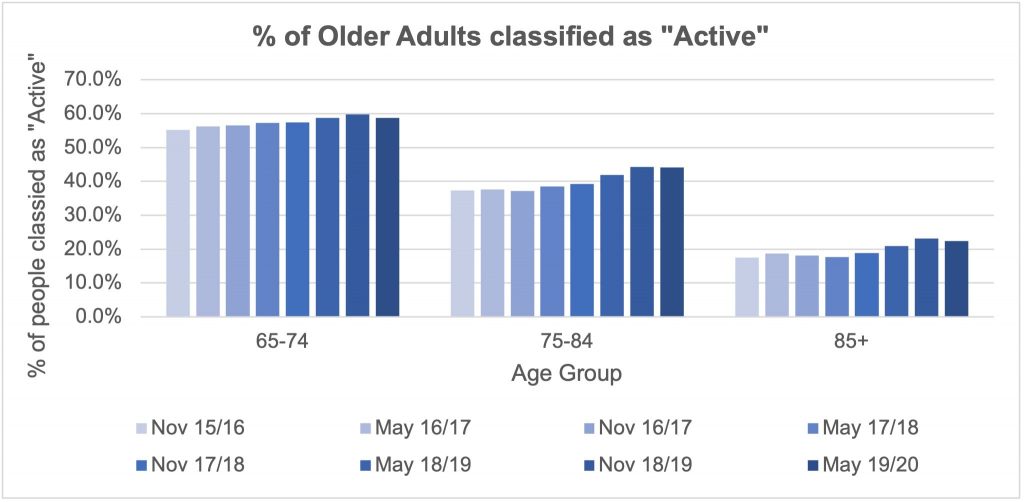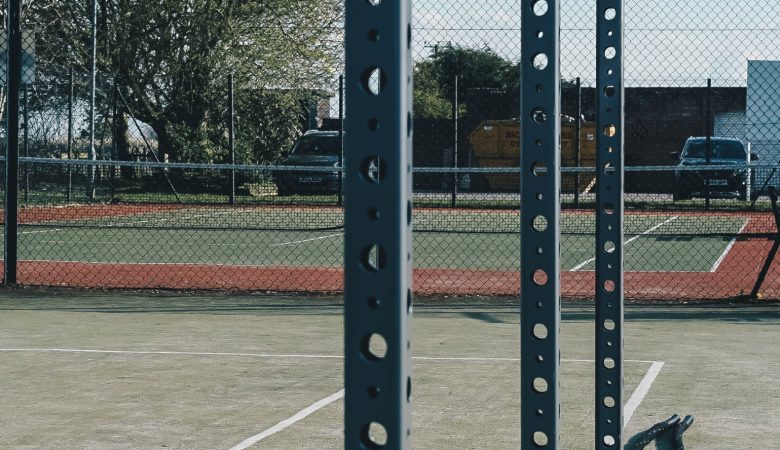4sight: Week 9 15/02/21
COVID19 has undone the steady upward trend in activity levels that was seen among the 65+ age group prior to March 2020. In this week’s 4sight we look at what can be done to get older adults back into facilities and being active, especially as vaccination rates gather pace.
Positive signs pre-pandemic
Older adults across the UK (65+) were getting more active each year in leisure venues between 2015 and early 2020, with increasing participation levels and greater amounts of social value being generated. In 2019, over 65s generated over £3.5 billion[1] of social value in the form of community health and wellbeing savings.
The growth in participation and social value is evidenced by Sport England Active Lives data, which shows that the number of 65+ individuals becoming “Active” (150+ mins of physical activity a week) was increasing, up to 2020. The chart below showcases that on average, the percentage of adults classified as active grew by 1.3% year on year, with the biggest growth in the 75-84 age range (1.7% yearly trend). The 85+ age group showed the biggest proportional increase with a 28% increase since Nov 15/16 to May 19/20.

These findings are emphasised by research undertaken from 826 consistent sites across the DataHub, which highlights a growth of 6.8% in visits for the 65+ age group prior to the pandemic, versus the same period the previous year (Jan/Feb 19 vs Jan/Feb 20). See week 6 of 4sight for greater detail in this area.
The changing nature of the industry post COVID19
While the trend for the 5 years preceding the pandemic were positive, the combination of increased health risk, lesser technological competence and lower social mobility represents a major threat to activity levels in older adults during 2021 and beyond.
Data from The National Post Lockdown Recovery Survey 2020, undertaken by Leisure-net in collaboration with 4global, BigWave Media and Max Associates, indicates that there is a clear inverse relationship between the age of a member and the likelihood of them using facilities more post pandemic[2]. Furthermore, the data indicates that the 65+ age group had the lowest proportion of members willing to spend more time being active.
Recapturing enthusiasm and returning the Silver Pound to the industry
While the previously upward trend has been reversed in the short term, data and insight identifies areas where the sector can focus, in order to bring older adults back into facilities.
The table below shows the proportion of visits by 65+ users to three key activity categories, viewed longitudinally. The data indicates that swimming represented a far higher share of participation following the return to facilities in lockdown 1.0, compared with 2019 and 2020 (pre-pandemic). Fitness also shows a significant rise, while group workout shows a decline, largely driven by social distancing restrictions placed upon the industry.

The data shows that provision of a service and activity that cannot be undertaken at home or outside of a facility remains valuable for the older adults, which is supported by further findings from the Leisure-net survey. 65+ members valued online classes lower than any other age group, with data also showing that this age group had the lowest proportion of people doing weekly home workouts during periods of lockdown.
Finally, an interesting consideration is that the element the 65+ members are missing when not able to access facilities is the social aspect, outstripping the access provided by instructors and coaches, or the competitive element with other members.
It’s clear that challenging times lie ahead for the industry and that a previously growing part of the sector now represents a threat, however with the right insight and a shift in approach for these members, there are opportunities to offer services that cannot be found elsewhere.
The analysis in this week’s 4sight uses data from the DataHub (www.datahubclub.com), to understand how people have been keeping active when not in lockdown. This analysis has used a sample of over 7 million visits from 826 leisure centres across the last 2 years.
For further information or to enquire about 4GLOBAL’s insight services, including the COVID19 Business Recovery Modelling, please contact enquiries@4global.com.
[1] On average an older person (65+) who meets the SV threshold (4+ times a month ? 150+ mins of activity), generates £675 of community savings annually. With approximately 5.2 million over 65s meet the criteria to generate SV, this equates to approximately £3.5 billion worth of community savings annually from this age group.
[2] The National Post Lockdown Recovery Survey (2020): Leisure-net Solutions


